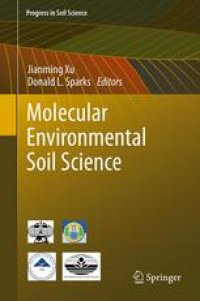
Ebook: Molecular Environmental Soil Science
- Tags: Environmental Science and Engineering, Ecotoxicology, Bioorganic Chemistry
- Series: Progress in Soil Science
- Year: 2013
- Publisher: Springer Netherlands
- Edition: 1
- Language: English
- pdf
Based on the “International Symposium of Molecular Environmental Soil Science at the Interfaces in the Earth’s Critical Zone,” this book focuses on the Critical Zone supporting life at the Earth’s surface with emphasis on the new and emerging subject area of molecular environmental soil science. Advances in research methodology, the use of synchrotron radiation in particular, are extensively reviewed. Roles of microbes, biomolecules, and environmental nanoparticles in mineral transformations, metal cycling, degradation of natural and anthropogenic organic compounds are also extensively reviewed. It is unique in terms of facilitating the integration of contributions from traditionally separate disciplines and adding a molecular and nanoparticle (therefore chemical) dimension to a field of endeavour that has traditionally been viewed on a different scale (dimension). It will also contribute to identifying knowledge gaps, providing future research directions and promoting research and education at the molecular level in this extremely important and challenging area of science for years to come. The IUPAC Project Committee noted that the Conference identifies, and builds on, the need to view and understand the Critical Zone at the molecular level. The book will be an invaluable reference for research and education.
This book focuses on the Critical Zone supporting life at the Earth’s surface with emphasis on the new and emerging subject area of molecular environmental soil science. Advances in research methodology, and the use of synchrotron radiation in particular, are extensively reviewed. The role of microbes and biomolecules in mineral transformations, metal cycling, and the degradation of natural and anthropogenic organic compounds are also highlighted. The book is unique because it integrates a number of key contributions from traditionally separate disciplines. It also adds an important, and much needed, molecular dimension to an area of science that has traditionally been viewed on larger scales. The book identifies knowledge gaps, provides future research directions and addresses advances in research and education at molecular level. in this extremely important and challenging area of science for years to come. The International Union of Pure and Applied Chemistry (IUPAC) Project Committee noted that the Conference, on which the book is based, identifies and builds on the need to view and understand the Critical Zone at the molecular level. The book will be an invaluable reference for researchers, students and professionals in this field of work.